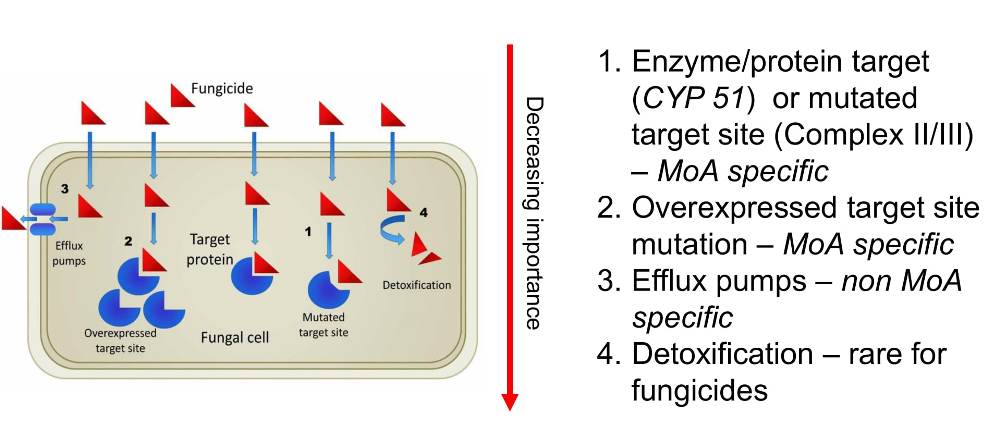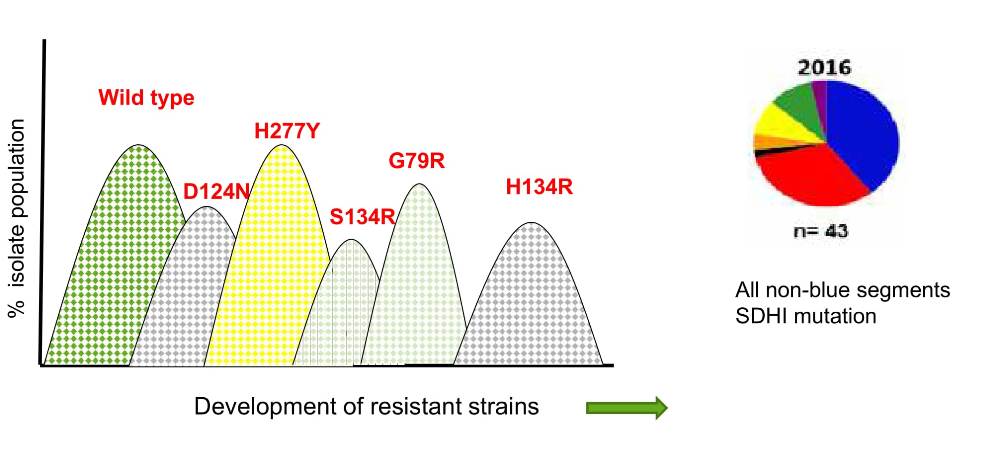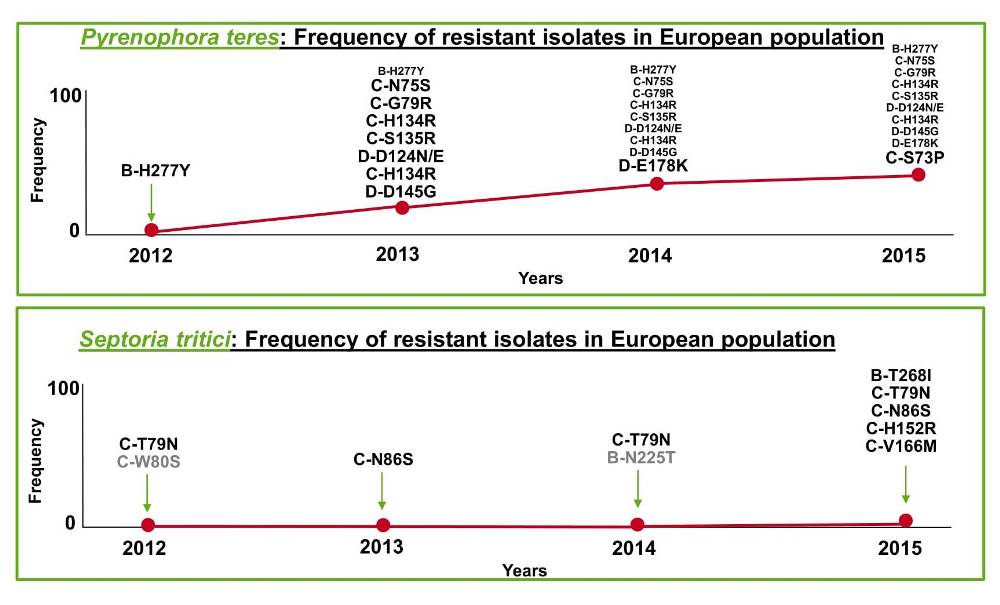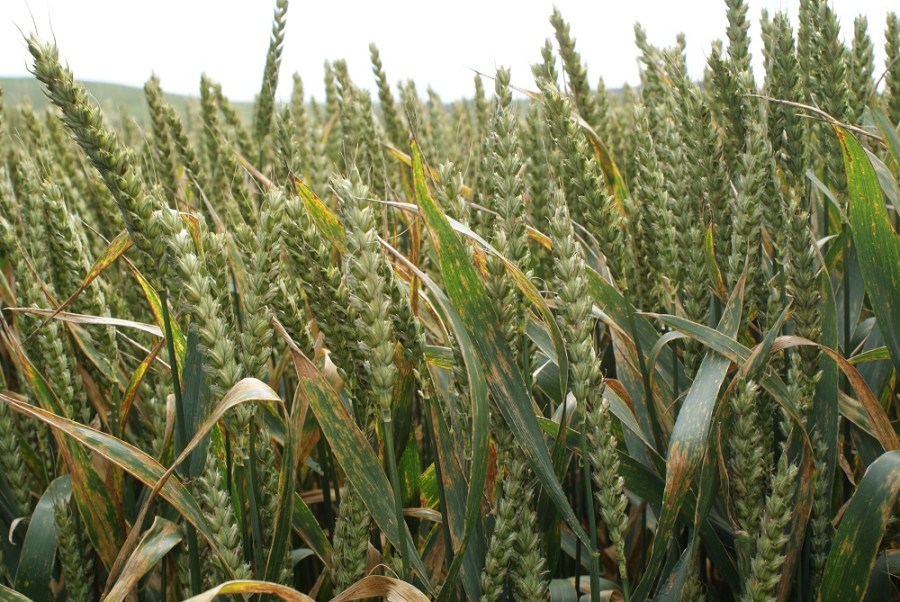Not all fungicide resistance is the same so can we reliably predict what the future holds for SDHIs? CPM finds out more about the issue.
Resistance in the SDHIs is likely to be more complex.
By Lucy de la Pasture
The subject of septoria resistance is on every pre-season technical agenda. The reason why the emergence of SDHI-resistant field strains is of such interest is that no one really knows precisely how and when the resistance will emerge in the septoria population. The complexities of the target enzyme, succinate dehydrogenase (SDH), is one of the reasons why.
Past experience with the MBCs and QoIs, as well as mutagenic studies in the lab, sheds some light on the issue. But what do the major SDHI manufacturers think will happen? After all, they painstakingly discovered the active ingredient, spent more than a decade bringing it to market and in the process invested the equivalent of nine Brink’s Mat gold bullion robberies in so doing. Monitoring for resistance issues is more than just a legal requirement for the R&D companies that brought us the SDHIs – it’s about the life and death of their products.
At the AICC conference in Jan, specialists at both Bayer and BASF gave delegates their take on the current state of play in septoria and the future of their chemistry. Plant pathologist Dr Rosie Bryson, BASF’s team lead for arable crop fungicide development in Europe, explains her concerns.
Relative importance of resistance mechanisms

Enzyme target site (CYP51) or mutated target site are the most common resistance mechanisms in septoria. Source: John Lucas, 2014
“Potential resistance to SDHIs is of importance because in the UK we’re currently reliant on just three modes of action for septoria control – the DMIs (azoles), SDHIs and multi-sites. Increasing costs and development time for producing new actives plus increasing restrictions due to legislation mean there are no quick fixes on the horizon for septoria control.”
In septoria, the resistance mechanisms employed by the fungus depends on the mode of action of the fungicide. Azole fungicides act on fungal cells by inhibiting membrane synthesis and they do this by targeting an enzyme CYP 51 which effects membrane structures.
Both the QoIs (strobilurins) and SDHIs act on the fungal cells’ ‘power houses’, the mitochondria responsible for the pathogens energy production. The target enzyme of SDH inhibitors is SDH, (so-called complex II in the mitochondrial respiration chain), which is a functional part of the tricarboxylic cycle and linked to the mitochondrial electron transport chain.
Pattern of SDHI resistance emergence in net blotch in Europe.

Net blotch resistance in Europe has been more complex than to the QoIs (strobilurins). Source: BASF
SDH consists of four subunits (A, B, C and D) and the binding site of the SDHIs (the ubiquinone binding site) is formed by the subunits B, C and D. Target site mutations conferring reduced sensitivity can develop in all three subunits, which is the reason for the complex nature of resistance patterns to SDHI fungicides compared with the QoIs.
It’s the position of the mutation at the SDH target site that determines the names given to the mutant strains, such as the much-discussed insensitive strain C-H152R, first discovered at a very low level in field populations in 2015. At first sight the coding seems confusing, but Rosie Bryson sheds some light on how these are derived.
Development of SDHI mutations

The speed of development of SDHI mutations in net blotch and septoria in Europe has been different to date. Source: FRAC
“The prefix given to a mutation, B, C or D, indicates the subunit of the SDH molecule where the mutation has occurred. The following letter (H in this case) indicates the amino acid that has been replaced in the wild type (original strain) septoria pathogen,” she explains.
“The numbers represent the position of the amino acid (in this case position 152) within the sequence where a change has occurred and the final letter (R in this case) represents the new amino acid in the mutated strain compared with the original wild type. So for septoria C-H152R, a mutation has occurred in subunit C of the SDH molecule, where the amino acid histidine (wild type) has been replaced at position 152 by amino acid arginine (mutant).
“The type of resistance we get to azole chemistry is continuous, resulting in a gradual shift in sensitivity over time. With the QoIs we witnessed discrete resistance, where there was a shift from the sensitive wild type to an insensitive mutant septoria strain (G143A) which happened more or less in one leap.
“Resistance in the SDHIs is more similar to the QoIs as it is target-site based but is likely to be more complex due to the possibility for a larger number of mutations compared with the QoIs. As has already been seen with the barley disease net blotch in France and Germany, several SDHI mutations have occurred which have a variable impact on the sensitivity of the SDHI fungicides,” she suggests.
The big question mark hanging over the SDHIs at the moment is Darwinian. Is septoria resistance in the emerging phase in the UK and Ireland or is the fitness penalty in the current mutations too great to outcompete the wild type?
Bayer’s fungicide resistance expert, Dr Andreas Mehl, believes some of the sensitivity monitoring to date may hint that fitness penalties are playing a part.
“More than 15 different SDHI target site mutations have been identified today, mostly in the lab but with an increasing number being found in field populations. However, very few field isolates seem to cause high resistance factors for our SDHIs’ bixafen and fluopyram,” he explains.
Bayer have recently introduced a new fungicide containing these two SDHIs to the UK and Andreas Mehl was keen to explain that this did not offer an anti-resistance strategy, even though they exhibit incomplete cross-resistance in lab tests.
“Ascra Xpro (bixafen+ fluopyram+ prothioconazole) was developed to provide added protection to the prothioconazole partner and not as an anti-resistance strategy for SDHIs. The mixture of SDHIs in Ascra provide an improved level of septoria control and each SDHI picks off different isolates within the septoria population (incomplete cross-resistance) but our long-term focus is on protecting our DMI chemistry,” he stresses.
In-line with FRAC, SDHI mixtures are not regarded as resistance management tools and must be applied together with effective non-cross-resistant partners such as a DMI fungicide. According to Andreas Mehl, Ascra does offer enhanced resistance management to its DMI partner, because the complimentary effects between the two different SDHIs it contains strengthens septoria control.
“Application of SDHI mixtures count as one SDHI spray. Due to lower intrinsic activity of fluopyram compared to bixafen, the overall SDHI dose needs to be adapted, but requires sound protection by a strong (DMI) partner.”
Whether there’s a double-whammy effect through this approach is another area of debate. Rosie Bryson questions whether an SDHI mixture will inevitably increase the selection pressure on the SDHIs because of the dose effect, though Andreas Mehl is unconvinced that dose plays a role in selecting for all mutant strains with SDHI chemistry.
So what is cross-resistance and incomplete cross-resistance? All the SDHIs are within the same cross-resistance group but differences in efficacy between them have been observed on different mutant strains, explains Rosie Bryson.
According to FRAC, work with isolates from both field and lab studies suggests that cross-resistance patterns between SDHIs for different target site mutations are complex. They confer varying degrees of insensitivity between the different SDHIs. This suggests the effect of these target site mutations on field performance of specific SDHIs may vary in field populations due not only to the mutation which may be present but also the intrinsic efficacy of the active ingredient itself.
The various degrees of reduced sensitivity to different target site mutations may be explained by structural differences between classes of SDHIs and how they interact with the target site of a specific pathogen. But the degree and importance of incomplete cross-resistance in septoria populations, when a mutant strain remains sensitive to one SDHI but resistant to others, is something that is a subject of much debate and isn’t yet fully understood.
SRUC’s Prof Fiona Burnett believes the debate over incomplete cross-resistance is a bit of a red herring and although there appears to be small differences in efficacy between the SDHIs on some mutations, this will probably disappear as resistance emerges.
“We saw similar differences in efficacy in the azoles in the very early stages when resistance was emerging but as further target site mutations occurred, the differences become less significant,” she explains.
In a published review of the current knowledge of the resistance aspects of the SDHIs, it was noted that it’s crucial to determine the genetic background to evaluate the cross-resistance behaviours of the SDHIs.
According to the authors, Helge Sierotzki and Gabriel Scalliet of Syngenta, “Frequently, mutations display different resistance patterns depending on the species they occur in. In addition, relevant variation in sensitivity can be observed across isolates of the same species carrying the same mutation in the SDH enzyme.
“It indicates that other factors besides target sequence are involved in the sensitivity to SDHIs. However, despite all the differences and specific interactions described, it must be assumed that the SDHI fungicides are cross-resistant at least at the population level. This means that a particular pathogen can develop the optimal mutation or mix of mutations (in either individuals or populations), leading to reduced sensitivity or even resistance.”
Clearly the pattern of emergence of resistance to SDHI chemistry is going to be a complex affair and it’s impossible to predict what will happen in septoria by looking at the resistance patterns that have emerged in other pathogens.
Rosie Bryson concludes that while there have been no reports of field failure or reduced SDHI fungicide performance due to SDHI mutations in septoria, she fully expects resistance to emerge at some point in the future with the UK and Ireland being at greatest risk – though more slowly than to the QoIs with the impact on field performance hard to predict.
“Resistance management is essential to maintain SDHIs in the market as long as possible and robust doses of an effective azole will play a key role. Resistance management is everyone’s responsibility,” she notes.
Resistance key points
- It’s normal to find a range of septoria strains in a population.
- The current dominant mutants are still sensitive to SDHIs.
- The resistant strain C-H152R is rare but present.
- Naming of septoria strains indicates the mutation that has occurred.
- All SDHIs are in the same fungicide group, so there is cross-resistance.
- Small differences in efficacy between SDHIs will likely become less significant in time.
Keep concern about ‘tough guys’ in proportion.
In an exclusive chat with CPM, Andreas Mehl explains his seemingly relaxed approach to the emerging threat of SDHI resistance.
“I don’t want to give the impression that everything is fine (regarding the SDHIs) but it’s important to be realistic about what’s actually going on in the field and we need a better understanding of this. It’s absolutely normal to detect strains of a pathogen that require more active ingredient to control it, right from the beginning when monitoring of any new fungicide product commences.
“Now it’s becoming cheaper to fully sequence the DNA of septoria strains, then these extreme outliers will be highlighted more. There’s a tendency to talk only about these ‘tough guys’ which may go on to cause a problem, but also have a fitness penalty that’s too great for them to dominate in the population. Sure, these mutations play a role but how frequent are they in the field and how do they compete with the wild type?
“In net blotch, the five SDHIs all have little effect on B-H277Y in Europe, but it doesn’t make sense to extrapolate this to the same septoria mutation and assume the same pattern of resistance emergence will occur,” he says.
The view of many experts is that SDHI chemistry shouldn’t be over-used, so what is Andreas Mehl’s view on applying SDHIs at both the T1 and T2 timing?
He points to fungicide monitoring work in France, where only one SDHI application is allowed by the regulators. In regions of France where septoria pressure is high, there have been much larger shifts in sensitivity to prothioconazole.
“The DMIs need to be protected so why only apply one SDHI and three DMIs in the programme, two of these won’t have adequate protection and the strategy automatically will increase the selection pressure on the DMIs,” he says.
“I don’t understand the concept of reducing the number of SDHI applications in a high-pressure situation. It’s a dangerous strategy. In France, there’s a serious issue now with the DMIs because of this approach.
“It’s important to remain flexible in the programme and adjust strategy to disease pressure. Fortunately, in the UK agronomists know how to do this,” he comments.
SDHI insensitivity confirmed in UK net blotch
Mutated UK net blotch isolates that are less sensitive to SDHI fungicides have been detected at high enough frequencies to raise concerns about efficacy.
The discovery was made during tests on barley samples from a field that hosted an AHDB fungicide performance trial in 2016, in which straight SDHI products gave variable and poorer than expected performance against net blotch.
Although field control should not be significantly impacted in 2017, provided appropriate mixtures of actives are used, the findings provide further evidence of the need to follow guidance issued by the Fungicide Resistance Action Group UK (FRAG–UK).
Paul Gosling, who manages fungicide performance and resistance work at AHDB explains the situation.
“When compared with the previous three years, 2013 to 2015, the drop in straight SDHI performance in 2016 was quite pronounced. The two solo SDHIs trialled failed to achieve more than 30-40% control of net blotch, even at the full label rate.”
Leaf samples were taken from winter barley volunteers at the affected trial site by NIAB. From these samples, twelve net blotch isolates were isolated and tested for fungicide sensitivity. Additional genotyping showed that nine of these isolates contained mutations in the SDHI binding site formed by SDH subunits B, C and D. Three types of SDH mutations were detected: D-H134R (five isolates), C-S135R (three isolates) and C-H134R (one isolate). A clear genotype-to-phenotype relationship was also established, meaning that the mutant isolates were less sensitive to SDHIs.
Bart Fraaije, who conducted the screening studies at Rothamsted Research adds, “These mutations have been found in Europe but it is the first time they have been found at high frequencies in a UK population and it helps explain the poor performance observed in the 2016 trial.
“We’ll continue to monitor the situation to help establish the spread and frequency of SDH mutations in UK net blotch populations.”




